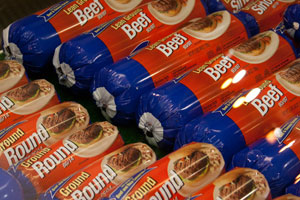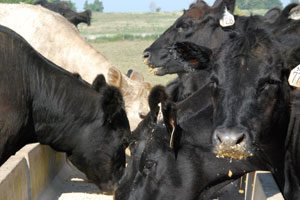So far in 2011, beef production has been one percent higher as result of both a few more head and higher weights. Exports have been an important demand stimulant. Since September 2010, the industry has exported a larger volume of beef than imported -- a rare historical event.
As an example, in the calendar year 2009, the industry imported more than they exported, with net imports accounting for three percent of domestic production. Imports greater than exports increases the domestic supply and lowers prices.
Since last September, exports have exceeded imports by an average of nearly 3 percent of domestic production. This means more beef is flowing out of the country than into the country so consumers have to pay higher prices for more limited supplies. So, while total beef production is up about 1 percent this year, the amount available for U.S. consumers is actually down about 2 percent because of the impacts of trade.
Domestic demand has been strong as well, but consumers are expected to become more reluctant buyers of beef as the spring and summer progresses. The continued slow recovery in the general economy has helped a few more people get back to work and rising stock market prices have increased the net worth of some households, making them feel a bit more comfortable.
However, there are troubling signs on the horizon for beef consumption.
 First is the continued rise in retail beef prices, which averaged a record $4.64 per pound in the first quarter of the year. That compares with just $4.23 per pound in the same quarter a year earlier. The difficulty facing beef demand is that retail prices probably have substantial increases still to come this spring and summer. It is likely that retail beef prices will move toward $5 per pound at times in coming months as retailers pass along the much higher prices of wholesale beef from this spring.
First is the continued rise in retail beef prices, which averaged a record $4.64 per pound in the first quarter of the year. That compares with just $4.23 per pound in the same quarter a year earlier. The difficulty facing beef demand is that retail prices probably have substantial increases still to come this spring and summer. It is likely that retail beef prices will move toward $5 per pound at times in coming months as retailers pass along the much higher prices of wholesale beef from this spring.
This will come at a time of severe pressure on household budgets as $4-plus gasoline and $5 beef have the potential to force adjustments in consumer behavior. For the entire year, expect retail beef prices to average $4.87 per pound, up 11 percent from last year.
Feed remains another major potential driver of the beef industry this summer, starting with the drought conditions in the Central and Southern Plains. The drought impact states of Texas, Oklahoma, Kansas, Colorado, and New Mexico represent 32 percent of the U.S. beef cow herd. The drought is generally expected to continue for most of this area, at least through July, so that cow liquidation could become a factor.
Fortunately, it appears that much of the Northern Plains and Midwest will have abundant moisture and some of these cows can be relocated further north and east. However, a number may move to slaughter, increasing the beef supply and edging cattle prices lower. Of course, the greater any forced liquidation of cows this summer, the higher cattle prices will rise in 2012 and later.
Corn is the second big feed issue. There is no sign that cattle feeders (or any other livestock producers) have backed down on corn consumption plans for this summer. The number of cattle on-feed, as an example, remained 5 percent higher on April 1, with 7 percent more steers and 2 percent more heifers in feedlots. There remain major questions regarding just how much old crop corn is available, about how high gasoline prices could impact corn demand for ethanol, and how foreign buyers will respond if corn availability becomes even tighter. To these concerns we can add a slow start to the 2011 planting season and escalating new-crop corn prices.
Finished cattle prices are expected to moderate from spring highs in the low $120s. Second quarter prices are expected to average near $117, with third quarter prices a few dollars lower. End-of summer lows could be in the $110 to $112 range. If drought forces cow liquidation, summer prices could even be lower. Prices should rally back into the $117 to $120 range in the fall and continue to move upward into the early spring of 2012.
Overall, much higher cattle prices than historic norms are expected in coming years. However, producers should secure feed supplies for this summer and continue to manage margin risks very closely. ![]()
PHOTO top by Show-Me Agri Comm
Feeder cattle prices are expected to average near $117/cwt in the second quarter after being above $120 for the start of 2011.
PHOTO below by David Cooper
Retail prices for beef are expected to average around $4.87 per pound this year, compounded further by higher demand among export nations.








